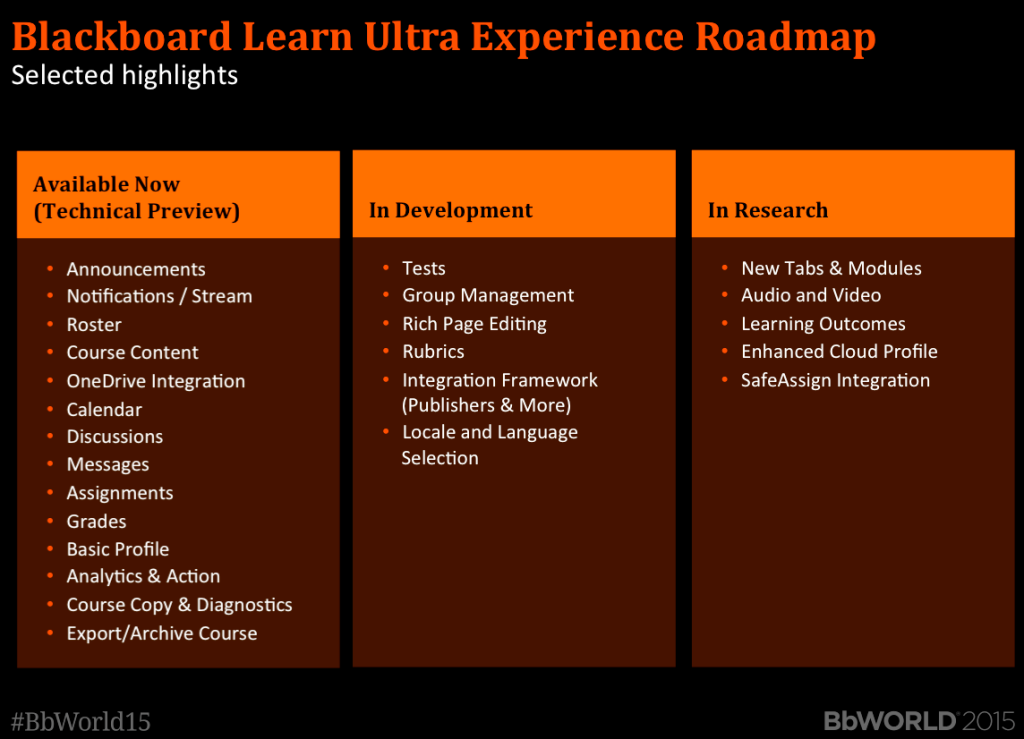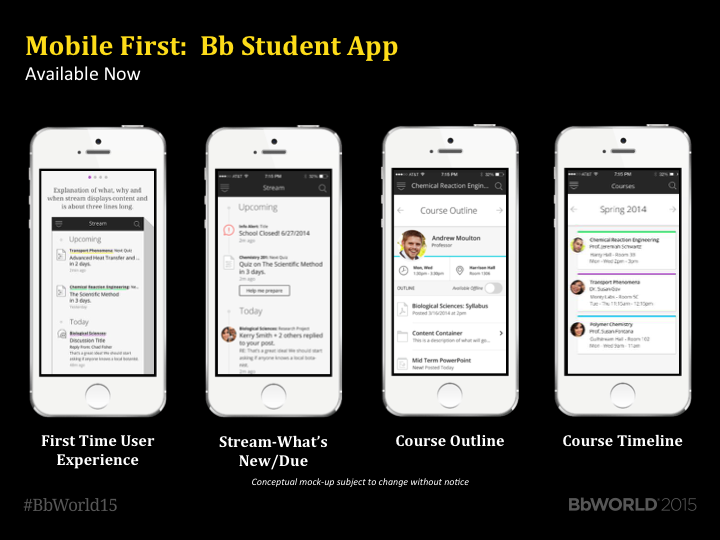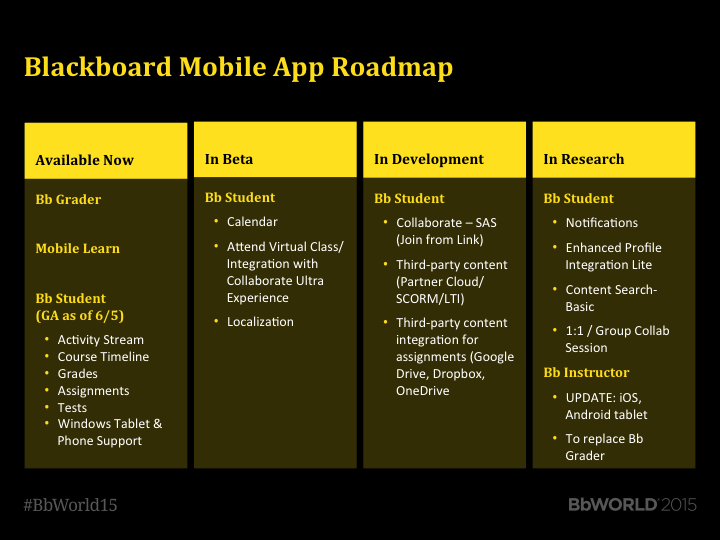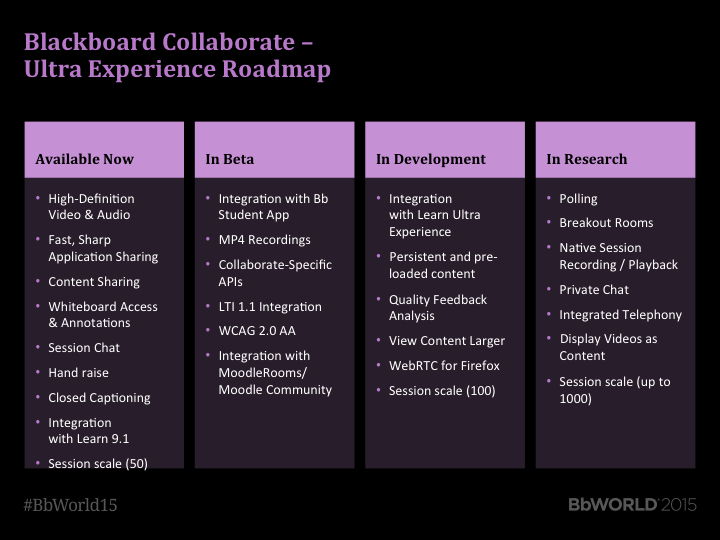Phil and I spent much of this past week at BbWorld trying to understand what is going on there. The fact that their next-generation Ultra user experience is a year behind is deservedly getting a lot of attention, so one of our goals going into the conference was to understand why this happened, where the development is now, and how confident we could be in the company’s development promises going forward. Blackboard, to their credit, gave us tons of access to their top executives and technical folks. Despite the impression that a casual observer might have, there is actually a ton going on at the company. I’m going to try to break down much of the major news at a high level in this post.
The News
Ultra is a year late: Let’s start with the obvious. The company showed off some cool demos at last year’s BbWorld, promising that the new experience would be Coming Soon to a Campus Near You. Since then, we haven’t really heard anything. So it wasn’t surprising to get confirmation that it is indeed behind schedule. What was more surprising was to see CEO Jay Bhatt state bluntly in the keynote that yes, Ultra is behind schedule because it was harder than they thought it would be. We don’t see that kind of no-spin honesty from ed tech vendors all that often.
Ultra isn’t finished yet: The product has been in use by a couple of dozen early adopter schools. (Phil and I haven’t spoken with any of the early adopters yet, but we intend to.) It will be available to all customers this summer. But Blackboard is calling it a “technical preview,” largely because there are large swathes of important functionality that have not yet been added to the Ultra experience–things like tests and groups. It’s probably fine to use it for simple (and fairly common) on-campus use cases, but there are still some open manholes here.
Ultra is only available in SaaS at the moment and will not be available for on-premise installations any time soon: This was a surprise both to us and to a number of Blackboard customers we spoke to. It’s available now for SaaS customers and will be available for managed hosting customers, but the company is making no promises about self-hosted. The main reason is that they have added some pretty bleeding edge new components to the architecture that are hard to wrap up into an easily installable and maintainable bundle. The technical team believes this situation may change over time as the technologies that they are using mature—to be clear, we’re talking about third-party technologies like server containers rather than homegrown Blackboard technologies—they think it may become practical for schools to self-host Ultra if they still want to by that time. But don’t expect to see this happen in the next two years.
Ultra is much more than a usability makeover and much more ambitious than is commonly understood: There is a sense in the market that Ultra is Blackboard’s attempt to catch up with Instructure’s ease of use. While there is some truth to that, it would be a mistake to think of Ultra as just that. In fact, it is a very ambitious re-architecture that, for example, has the ability to capture a rich array of real-time learning analytics data. These substantial and ambitious under-the-hood changes, which Phil and I were briefed on extensively and which were also shared publicly at Blackboard’s Devcon, are the reason why Ultra is late and the reason why it can’t be locally installed at the moment. I’m not going to have room to go into the details here, but I may write more about it in a future post.
Blackboard “Classic” 9.x is continuing under active development: If you’re self-hosted, you will not be left behind. Blackboard claims that the 9.x code line will continue to be under active development for some time to come, and Phil and I found their claims to be fairly convincing. To begin with, Jay got burned at Autodesk when he tried to push customers onto a next-generation platform and they didn’t want to go. So he has a personal conviction that it’s a bad idea to try that again. But also, Blackboard gets close to a quarter of its revenue and most of its growth from international markets now, and for a variety of reasons, Ultra is not yet a good fit for those markets and probably won’t be any time soon. So self-hosted customers on Learn 9.x will likely get some love. This doesn’t mean development will be as fast as they would like; the company is pushing hard in a number of directions, and we get the definite sense that there is a strain on developer resources. But 9.x will not be abandoned or put into maintenance mode in the near future.
If you want to get a sense of what Ultra feels like, try out the Blackboard Student mobile app: The way Blackboard uses the term “Ultra” is confusing, because sometimes it means the user experience but sometimes it means the next generation architecture for Learn. If you want to try Ultra the user experience, the play with the Student mobile app, which is in production today and which will work with Learn 9.x as well as Learn Ultra. Personally, I think it represents some really solid thinking about designing for students.
Moodle may make a comeback: One of the reasons that Moodle adoption has suffered in the United States the past few years is that it has lacked an advocate with a loud voice. Moodlerooms used to be the biggest promoter of the platform, and when Blackboard acquired them, they went quiet in the US. But, as I already mentioned, the international market is hugely important for Blackboard now, and Moodle is the cornerstone of the company’s international strategy. They have been quietly investing in the platform, making significant code contributions and acquisitions. There are signs that Blackboard may unleash Moodlerooms to compete robustly in the US market again. This would entail taking the risk that Moodle, a cheaper and lower-margin product, would cannibalize their Learn business, so file this under “we’ll believe it when we see it,” but Apple has killed the taboo of self-cannibalization when the circumstances are right, and they seem like they may be right in this situation.
Collaborate Ultra is more mature than Learn Ultra but still not mature: This is another case where thinking about Ultra as a usability facelift would be hugely underestimating the ambition of what Blackboard is trying to do. The new version of Collaborate is built on a new standard called WebRTC, which enables webconferencing over naked HTML rather than through Flash or Java. This is extremely hard stuff that big companies like Google, Microsoft, and Apple are still in the process of working out right now. It is just this side of crazy for a company the size of Blackboard to try to release a collaboration product based heavily on this technology. (And the only reason it’s not on the other side of crazy is because Blackboard acquired a company that has one of the world’s foremost experts on WebRTC.) Phil and I have used Collaborate Ultra a little bit. It’s very cool but a little buggy. And, like Learn Ultra, it’s still missing some features. At the moment, the sweet spot for the app appears to be online office hours.
My Quick Take
I’m trying to restrain myself from writing a 10,000-word epic; there is just a ton to say here. I’ll give a high-level framework here and come back to some aspects in later posts. Bottom line: If you think that Ultra is all about playing catch-up with Instructure on usability, then the company’s late delivery, functionality gaps, and weird restrictions on where the product can and cannot be run look pretty terrible. But that’s probably not the right way to think about Ultra. The best analogy I can come up with is Apple’s Mac OS X. In both cases, we have a company that is trying to bring a large installed base of customers onto a substantially new architecture and new user experience without sending them running for the hills (or the competitors). This is a really hard challenge. Hardcore OS X early adopters will remember that 10.0 was essentially an unusable technology preview, 10.1 was usable but painful, 10.2 was starting to feel pretty good, and 10.3 was when we really began to see why the new world was going to be so much better than the old one. If I am right, Ultra will go through the same sort of evolution. I don’t know that these stages will each be a year long; I suspect that they may be shorter than that. But right now we are probably partway through the 10.0 era for Ultra. As I mentioned earlier in the post, Phil and I still need to talk to some Ultra customers to get a sense of real usage and, of course, since it will be generally available to SaaS customers for use in the fall semester, we’ll have more folks to talk to soon. We will be watching closely to see how big the gaps are and how quickly they are filled. For example, how long will it take Blackboard to get to the items labeled as “In Development” on their slides? Does that mean in a few months? More? And what about the “Research” column? Based on these slide and our conversations, I think the best case scenario is that we reach the 10.2 era—where the platform is reasonably feature-complete, usable, and feeling pretty good overall—by BbWorld 2016, and with some 10.3-type new and strongly differentiating features starting to creep into the picture. Or they could fall flat and utterly fail to deliver. Or something in between. I’m pretty excited by the scope of the company’s ambition and am willing to cut them some slack, partly because they persuaded me that what they are trying to do is pretty big and party because they persuaded me that they probably know what they are doing. But they have had their Mulligan. As the saying goes (when properly remembered), the proof of the pudding is in the eating. We’ll see what they deliver to customers in the next 6-12 months.
Watch this space.





[…] This news should not be all that unexpected, as one common private equity strategy is to reorganize and clean up a company (headcount, rationalize management structures, reorient the strategy) and then sell within 3 – 7 years. As we have covered here at e-Literate, Blackboard has gone through several rounds of layoffs, and many key employees have already left the company due to new management and restructuring plans. CEO Jay Bhatt has been consistent in his message about moving from a conglomeration of silo’d mini-companies based on past M&A to a unified company. We have also described the significant changes in strategy – both adopting open source solutions and planning to rework the entire user experience. […]